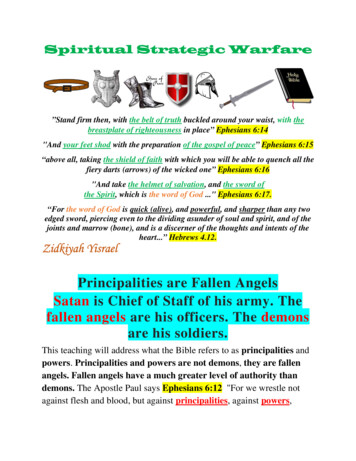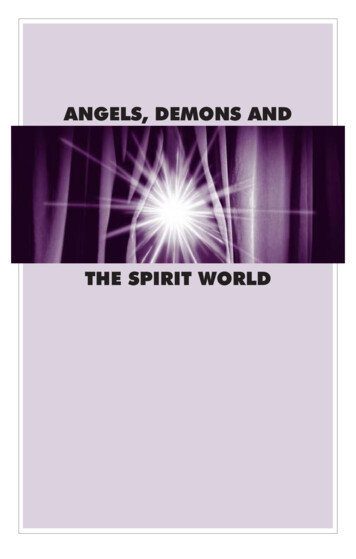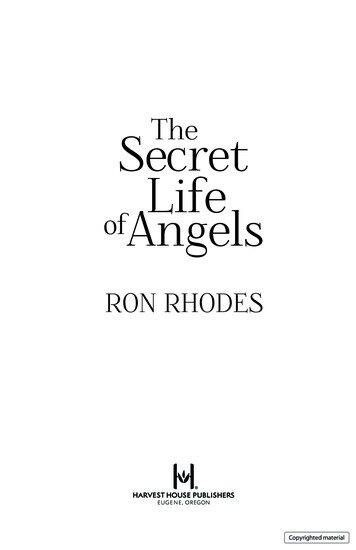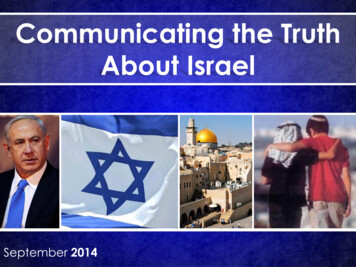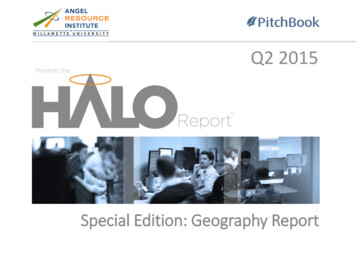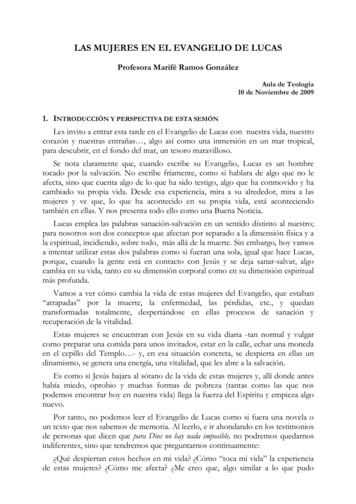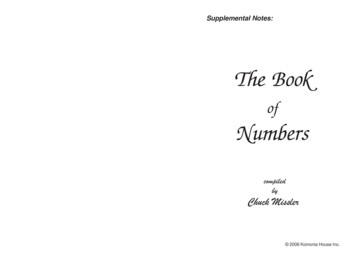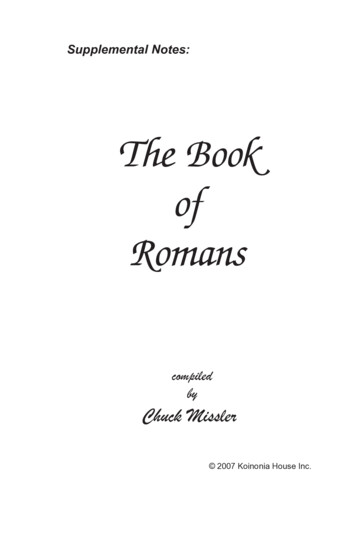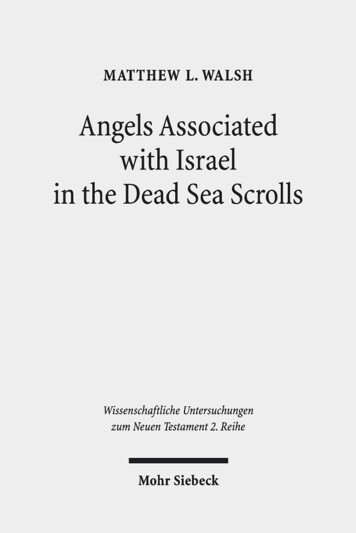
Transcription
Wissenschaftliche Untersuchungenzum Neuen Testament · 2. ReiheHerausgeber / EditorJörg Frey (Zürich)Mitherausgeber/Associate EditorsMarkus Bockmuehl (Oxford) James A. Kelhoffer (Uppsala)Tobias Nicklas (Regensburg) Janet Spittler (Charlottesville, VA)J. Ross Wagner (Durham, NC)509
Matthew L. WalshAngels Associated with Israelin the Dead Sea ScrollsAngelology and Sectarian Identity at QumranMohr Siebeck
Matthew L. Walsh, born 1978; 2016 PhD in Religious Studies (Second Temple Period Judaism and Early Christianity) from McMaster University in Hamilton, Ontario, Canada;since 2016 Assistant Professor of Biblical Studies, Acadia Divinity College in Wolfville, NovaScotia, Canada.ISBN 978-3-16-155303-5 / eISBN 978-3-16-155304-2DOI 10.1628 / 978-3-16-155304-2ISSN 0340-9570 / eISSN 2568-7484 (Wissenschaftliche Untersuchungen zum Neuen Testament, 2. Reihe)The Deutsche Nationalbibliothek lists this publication in the Deutsche Nationalbibliographie;detailed bibliographic data are available on the Internet at http://dnb.dnb.de. 2019 Mohr Siebeck Tübingen, Germany. www.mohrsiebeck.comThis book may not be reproduced, in whole or in part, in any form (beyond that permitted bycopyright law) without the publisher’s written permission. This applies particularly to reproductions, translations and storage and processing in electronic systems.The book was printed by Laupp & Göbel in Gomaringen on non-aging paper and bound byBuchbinderei Nädele in Nehren.Printed in Germany.
For Christine, Elijah, Joseph,Sarah, and Oliver
PrefaceThis study is a revision of my doctoral dissertation, which was defended on 24June 2016 at McMaster University in Hamilton, Ontario. A dissertation/bookmay be written by one person, but without the wisdom, assistance, and diligence of numerous individuals, it would not have seen the light of day.First, I am profoundly grateful for the astute and consistent supervision ofEileen Schuller, whose knowledge and scholarly acumen are only surpassed bythe concern she has for her students. Though I am responsible for any shortcomings, this project is unquestionably stronger because of her excellent guidance. I also owe a tremendous debt of gratitude to Daniel Machiela and Stephen Westerholm, whose expertise and meticulous interaction with my workare greatly appreciated. Special thanks are due to Dana Hollander, who servedas the internal-external reader for the defense, and Joseph Angel of YeshivaUniversity, who served as the external reader. Their questions and suggestionsprompted invaluable insights that have sharpened my research. Additionally,my time at McMaster was supported by a doctoral fellowship from the SocialSciences and Humanities Research Council of Canada. On this point, a wordof thanks is due to the unsung hero of the McMaster Religious Studies department, Doreen Drew, who tirelessly organizes scholarship applications for thegraduate students.Second, I experienced a wonderful sense of camaraderie at McMaster, andI am thankful for my fellow former occupants of the University Hall basementoffices, particularly: Miriam DeCock, Michael Johnson, Andrew Krause, NickMeyer, Eric Montgomery, and Andy Perrin. I would also like to thank thefaculty and students who participated in the annual Dead Sea Scrolls conferences jointly organized by McMaster and the University of Toronto.Third, there are a host of people who have indirectly contributed to this project. For introducing me to the academic discipline of biblical studies, I amindebted to my former Acadia University professors, Timothy Ashley, AllisonTrites, Craig Evans, and Glenn Wooden. For moral support, I am grateful formy parents, Barrie and Alice Walsh, and my in-laws, Ray and Marilyn Monette. For their listening ears and friendship over the years, I thank AndrewBoone, Tammy Giffen, Matt Leyennar, Greg Monette, Danny Zacharias, andmy brother, Peter Walsh. For granting me time to write in 2015, I am thankfulfor the congregation of West End Baptist Church, particularly Lynn and Glenn
VIIIPrefaceAnderson, Suzanne and Jonathan Trites, and especially David Watt, who is anexemplary pastor, mentor, and friend. I would also be remiss not to thank mysupportive colleagues, the faculty and staff of Acadia Divinity College, including our recently retired boss, Harry Gardner.Jörg Frey, editor of the WUNT 2 series, accepted my work for publication,and both Henning Ziebritzki and Matthias Spitzner at Mohr Siebeck were helpful and patient as I prepared the manuscript. I thank the three of them for thisopportunity.Most of all, I am grateful for my wife, Christine, and our children, Elijah,Joseph, Sarah, and Oliver, who exude love and understanding on a daily basis.They have been a constant source of encouragement, and it is with joy that Idedicate this study to them.Matthew L. WalshFall River, Nova Scotia4 November 2019
Table of ContentsPreface . VIIAbbreviations . XIIIChapter 1: General Introduction, History of Research,and Objectives and Plan of Study . 1A. General Introduction . 1B. History of Research . 5I.II.III.IV.V.VI.VII.Angelology and Christology . 5Angelology and Anthropology . 6Angelology and Mysticism . 8Studies Focused on Angels . 10“Non-Sectarian” and “Sectarian” Texts . 14Sectarian Identity at Qumran . 21Summary and Points of Departure . 24C. Objectives and Plan of Study . 26Chapter 2: Angels Associated with Israel: ConceptualFoundations . 27A. Introduction . 27B. The Canaanite Divine Assembly . 27I. Who Is the High God of the Canaanite Assembly? . 28II. The Organization of the Divine Assembly . 30C. The Biblical Background of Angels Associated with Israel Part I:Angelic Guardians . 33
XI.II.III.IV.Table of ContentsDeuteronomy 32:8–9 .Psalm 82:1–8 .Isaiah 24:21–23 .Summary, A Curious Tension, and Israel’s Guardians .33404547D. The Biblical Background of Angels Associated with Israel Part II:Angelic Priests . 51I. Archetypal Celestial Sanctuary: Original Intention or LaterInterpretation? . 51II. Hints of an Angelic Priesthood? . 53III. Summary . 55Chapter 3: Angels Associated with Israel in Second TemplePeriod Qumran Texts of a Non-Sectarian Provenance . 56A. Introduction . 56B. Daniel 7–12 . 57I. The History, Structure, and Languages of Daniel 7–12 . 57II. Daniel 7 . 59Excursus: The Mythological Imagery of Daniel 7 . 67III. Daniel 8 . 73IV. Daniel 9 . 77V. Daniel 10–12 . 78VI. Summary . 83C. 1 Enoch . 83I. The Book of Watchers (1 Enoch 1–36). 84II. The Animal Apocalypse (1 Enoch 85–90) . 97III. The Epistle of Enoch (1 Enoch 91–108) . 105D. Aramaic Levi Document . 110E. Visions of Amram . 118F. Tobit . 122G. Jubilees . 126H. 4QInstruction . 135
Table of ContentsXII. The Son of God Text . 143J. Summary . 147Chapter 4: Angels Associated with Israel in the SectarianTexts Part I: Angelic Guardians . 149A. Introduction . 149B. Setting the Stage for Martial Angelic Fellowship . 150I. The Treatise on the Two Spirits (1QS III, 13–IV, 26) . 150Excursus: The Qumran Movement as the True Israel . 159II. 11QMelchizedek (11Q13) . 162C. The War Scroll and Related Texts . 172I. Passages Presupposing a Close Human-Angel Relationship . 173II. Humans and Angels: Comrades at the Eschatological War . 180III. The Sons of Light: The Identity of the Human Warriors . 188D. Summary . 201Chapter 5: Angels Associated with Israel in the SectarianTexts Part II: Angelic Priests . 202A. Introduction . 202B. The Hodayot and Related Texts . 203I. Angelic Fellowship in the Hodayot: Present and Liturgical . 204II. Angelic Fellowship as a Defining Sectarian Characteristic . 216C. Songs of the Sabbath Sacrifice . 225I. The Heavenly Temple and Angelic Priesthood of the Songsof the Sabbath Sacrifice . 226II. The Use and Significance of the Songs of the SabbathSacrifice: An Ideal Text for the True Israel . 235D. 4Q181, 4Q511, 1QSb, and the Self-Glorification Hymn . 252I. Pesher on the Periods B/Ages of Creation B (4Q181) . 252II. Songs of the Sage (4Q511) . 254
XIITable of ContentsIII. The Rule of Blessings (1QSb) . 258IV. The Self-Glorification Hymn . 262E. Summary . 273Chapter 6: Conclusions and Expanding the Scope . 275A. Conclusions . 275I.II.III.IV.Overview .Conceptual Foundations of Angels Associated with Israel .Affinities between Non-Sectarian and Sectarian Texts .The Uniqueness of the Sectarian Outlook .275275277278B. Expanding the Scope . 282Bibliography .Index of Ancient Sources .Index of Modern Authors .Index of Subjects .285319339347
LJBSacBTBZAWBZRGGCBQCBQMSCurBRCDSSECEJLCJASAnchor BibleAnchor Bible Dictionary. Edited by David Noel Freedman. 6 vols. NewYork: Doubleday, 1992.Anchor Bible Reference LibraryArbeiten zur Geschichte des antiken Judentums und des UrchristentumsAncient Judaism and Early ChristianityAncient Near Eastern Texts Relating to the Old Testament. Edited byJames B. Pritchard. 3rd ed. Princeton: Princeton University Press, 1969.Annals of the New York Academy of SciencesThe Aramaic BibleAmerican Schools of Oriental Research Monograph SeriesAbhandlungen zur Theologie des Alten und Neuen TestamentsActa Theologica DanicaArbeiten zu Text und Sprache im Alten TestamentAndrews University Seminary Doctoral Dissertation SeriesBiblical ArchaeologistBiblical Archaeology ReviewBulletin for Biblical ResearchBaker Commentary on the Old Testament Wisdom and PsalmsBibliotheca ephemeridum theologicarum lovaniensiumBiblicaBiblical Interpretation SeriesBrill Reference Library of JudaismBibliotheca SacraThe Bible TranslatorBeihefte zur Zeitschrift für die alttestamentliche WissenschaftBeihefte zur Zeitschrift für Religions – und GeistesgeschichteCatholic Biblical QuarterlyCatholic Biblical Quarterly Monograph SeriesCurrents in Biblical ResearchThe Complete Dead Sea Scrolls in English: Revised Edition. Géza Vermes. New York: Penguin Books, 2011.Commentaries on Early Jewish LiteratureChristianity and Judaism in Antiquity Series
TRHTSAbbreviationsCompanion to the Qumran ScrollsCorpus Scriptorum Christianorum OrientaliumCorpus des tablettes en cuneiforms alphabetiques découvertes à RasShamra-Ugarit de 1929 à 1939. Edited by Andrée Herdner. Paris:Geuthner, 1963.The Cuneiform Alphabetic Texts from Ugarit, Ras Ibn Hani, and OtherPlaces. Edited by Manfried Dietrich, Oswald Loretz, and JoaquinSanmartin. Münster: Ugarit-Verlag, 1995.Deuterocanonical and Cognate Literature StudiesDeuterocanonical and Cognate Literature YearbookDictionary of Deities and Demons in the Bible. Edited by Karel van derToorn, Bob Becking, and Pieter W. van der Horst. Leiden: Brill, 1995.2nd rev. ed. Grand Rapids: Eerdmans, 1999.Discoveries in the Judaean DesertDead Sea DiscoveriesThe Dead Sea Scrolls: A New Translation. Michael O. Wise, Martin G.Abegg, Jr., and Edward M. Cook. New York: Harper Collins, 1996.The Dead Sea Scrolls Study Edition. Florentino García Martínez andEibert J. C. Tigchelaar. 2 vols. Leiden: Brill. Grand Rapids: Eerdmans,1997–98.Eerdmans Commentaries on the Dead Sea ScrollsEncyclopedia of the Dead Sea Scrolls. Edited by Lawrence H. Schiffman and James C. VanderKam. 2 vols. New York: Oxford UniversityPress, 2000.Early Judaism and its LiteratureEtudes préliminaires aux religions orientals dans l’empire romainEphemerides Theologicae LovaniensesForschungen zum Alten TestamentFolia OrientaliaForms of the Old Testament LiteratureGuides to the Apocrypha and PseudepigraphaThe Hebrew and Aramaic Lexicon of the Old Testament. Ludwig Koehler, Walter Baumgartner, and Johann J. Stamm. Translated and editedunder the supervision of Mervyn E. J. Richardson. 4 vols. Leiden: Brill,1994–1999.Hebrew Annual ReviewHebrew Bible and Ancient IsraelHandbuch der OrientalistikHenochHarvard Semitic MonographsHarvard Semitic StudiesHarvard Theological ReviewHarvard Theological Studies
NTLNTSOTLOTPOTSOtStXVHebrew Union College AnnualInternational Critical CommentaryIsrael Exploration JournalImmanuelInterpretationIsrael Oriental StudiesJudaïsme Ancien – Ancient JudaismJournal of Ancient JudaismJournal of Ancient Judaism SupplementsJournal of Biblical LiteratureJournal of Biblical StudiesJewish and Christian Texts in Context and Related StudiesJournal for the Evangelical Study of the Old TestamentJournal of Hebrew ScripturesJournal of Jewish StudiesJournal of Near Eastern StudiesJewish Publication Society Torah CommentaryJewish Quarterly ReviewJournal for the Study of Judaism in the Persian, Hellenistic, and RomanPeriodsSupplements to the Journal for the Study of JudaismJournal for the Study of the Old TestamentJournal for the Study of the Old Testament Supplement SeriesJournal for the Study of the PseudepigraphaJournal for the Study of the Pseudepigrapha Supplement SeriesJournal of Semitic StudiesJournal of Theological StudiesDie keilalphabetischen Texte aus Ugarit. Edited by Manfried Dietrich,Oswald Loretz, and Joaquin Sanmartin. Münster: Ugarit-Verlag, 2013.Library of Hebrew Bible/Old Testament StudiesLibrary of New Testament StudiesLibrary of Second Temple StudiesMasoretic TextNew International Commentary on the Old TestamentSupplements to Novum TestamentumNew Revised Standard VersionNew Testament LibraryNew Testaments StudiesOld Testament LibraryThe Old Testament Pseudepigrapha. Edited by James H. Charlesworth.2 vols. New York: Doubleday, 1983, 1985.Old Testament StudiesOudtestamentische Studiën
breviationsPrinceton Theological Seminary Dead Sea Scrolls ProjectPseudepigrapha Veteris Testamenti GraeceRevue bibliqueReview of Biblical LiteratureRevue de QumrânRevue de l’histoire des religionsSources bibliqueSociety of Biblical Literature Dissertation SeriesSociety of Biblical Literature Monograph SeriesSociety of Biblical Literature Seminar PapersSociety of Biblical Literature Symposium SeriesStudies in Biblical TheologyScripta HierosolymitanaSeptuagint and Cognate StudiesStudies in the Dead Sea Scrolls and Related LiteratureStudies in Judaism in Late AntiquityStudi e materiali di storia delle religioniSociety for New Testament Studies Monograph SeriesStudia Semitica NeerlandicaStudia Semitica UpsaliensiaStudien und Texte zu Antike und ChristentumStudies in Biblical Literature (Lang)Studies on the Texts of the Desert of JudahSubsidia BiblicaStudien zur Umwelt des Neuen TestamentsSeptuaginta Vetus Testamentum GraecumStudia in Veteris Testamenti PseudepigraphicaThemes in Biblical NarrativeTheological Dictionary of the New Testament. Edited by Gerhard Kitteland Gerhard Friedrich. Translated by Geoffrey W. Bromiley. 10 vols.Grand Rapids: Eerdmans, 1964–1976.Theological Dictionary of the Old Testament. Edited by G. JohannesBoatterweck, Helmer Ringgren, and Heinz-Josef Fabry. Translated byDavid E. Green and Douglas W. Scott. 16 vols. Grand Rapids: Eerdmans, 1974–2018.Theological Lexicon of the Old Testament. Edited by Ernst Jenni andClaus Westermann. Translated by M. E. Biddle. 3 vols. Peabody: Hendrickson, 1997.Texte und Studien zum antiken JudentumTheologische Studien und KritikenTheological Wordbook of the Old Testament. Edited by R. Laird Harris,Gleason L. Archer, Jr., and Bruce K. Waltke. 2 vols. Chicago: TheMoody Bible Institute, 1980.
WZTKXVIITyndale BulletinVetus TestamentumSupplements to Vetus TestamentumWord Biblical CommentaryWisdom Literature from the Ancient WorldWissenschaftliche Monographien zum Alten und Neuen TestamentWissenschaftliche Untersuchungen zum Neuen TestamentZeitschrift für die alttestamentliche WissenschaftZeitschrift für katholische TheologieZeitschrift für neutestamentliche Wissenschaft und die Kunde der älteren KircheZeitschrift für Theologie und Kirche
Chapter 1General Introduction, History of Research,and Objectives and Plan of StudyA. General IntroductionAngelic beings are depicted in a variety of ways in the Hebrew Bible: as messengers, as military commanders, and as protectors of the faithful, but for themost part they are unnamed and relatively undeveloped as characters. It isnot until the middle of the Second Temple Period that we begin to witnessheightened interest in angels. Many developments stem from reflection uponbiblical themes and categories, as angels are creatively assigned names,ranks, and duties with ever-increasing specificity.1An aspect of Hebrew Bible angelology 2 that was the subject of considerable speculation in the Second Temple Period – and a main concern of the present study – was the concept that certain angels were closely associated withIsrael. These angels are cast as having at least two vocations, though not infrequently there is overlap between them. 1.) Angels who served as theguardians of God’s people: while angelic assistance or support for Israel intimes of trouble or war has considerable biblical precedent (e.g., Exod 14:19;Josh 5:13–15; 2 Kgs 19:35), the early Jewish expansion of this concept includes the notions that certain angels were warriors who strived against theangels associated with Israel’s enemies in the celestial realm and/or weregranted a prominent role in the eschatological deliverance of God’s people. 31On this development, see Larry W. Hurtado, “Monotheism, Principal Angels, and theBackground of Christology,” in The Oxford Handbook of the Dead Sea Scrolls (eds., Timothy H. Lim and John J. Collins; Oxford: Oxford University Press, 2010), 550–551.2Kevin P. Sullivan, Wrestling with Angels: A Study of the Relationship between Angelsand Humans in Ancient Jewish Literature and the New Testament (AJEC 55; Leiden: Brill,2004), 7, echoes the oft-noted warning that the term “angelology” be used with caution as itcan misleadingly suggest that a given text or corpus is systematic in its presentation of angelic beings. I use “angelology” here and elsewhere mindful of the diversity with which angelsare portrayed both in the Hebrew Bible and in the literature of the Second Temple Period.3For an introduction, see Darrell D. Hannah, “Guardian Angels and Angelic National Patrons in Second Temple Judaism and Early Christianity,” in Angels: The Concept of CelestialBeings – Origins, Development and Reception (eds., Friedrich V. Reiterer, Tobias Nicklas,and Karen Schöpflin; DCLY; New York: de Gruyter, 2007), 413–435.
2Chapter 1: General Intro, History of Research, Objectives and Plan of Study2.) Angels who served as priests: a notion that is implicit at best in the Hebrew Bible yet a topic of interest in the Second Temple period literature isthat there were angelic priests who ministered in a heavenly temple. In thisscenario, the celestial sanctuary and its celebrants seemed to have been understood as the archetypes for Israel’s sanctuary and priesthood.4 A crucialcomponent of the presentation of both angelic guardians and priests was thatthey were envisioned within apocalyptic worldviews that assumed that“earthly realities reflect and mirror heavenly ones,”5 and a related development was that there was thought to be some kind of connection, correspondence, or parallel relationship between the realms. While angels associatedwith Israel could be a named or titled individual, another development – andone often found side-by-side with the notion of an angelic leader-figure – wasthat the existence, actions, and fates of the angelic host collectively wereconnected to the Jewish people on earth.Certain texts will be key to my discussion and will form the basis of muchof the analysis in subsequent chapters. Deuteronomy 32:8–9 is an obviousstarting point, as according to this text Yhwh has assigned celestial beings aguardian-like role over other nations, but he rules Israel directly. In contrast,the Enochic Book of Watchers suggests that, at least by the 3rd cent. BCE,there were those who thought there were named angels in heaven such asMichael, who is said to have a special relationship with God’s people (cf. 1En. 20:5). Similarly, the Book of Daniel (2nd cent. BCE) portrays Michael asexemplary among the angelic host, whose struggles and victories in the heavenly realm are paralleled in the lives of God’s people on earth (cf. Dan 10:13,21; 12:1). While Jubilees (also 2nd cent. BCE) contains no angels with propernames,6 a titled angelic class – “the angels of the presence” – and its eponymous leader are clearly marked as Israel’s heavenly counterparts and serve aspriests before God (cf. Jub. 2:2–30; 6:18; 15:27–28; 30:18; 31:14).7But a parallel relationship between the realms does not sufficiently explainsome of the claims of the Qumran texts, which speak of eschatological andeven present interaction or communion between angels and humans. As Iwill discuss at length in later chapters, the Qumran movement8 anticipatedthat they would fight in conjunction with the angels at the eschaton, as the4On the concept of heaven as a temple and suggestions for this development, see MarthaHimmelfarb, A Kingdom of Priests: Ancestry and Merit in Ancient Judaism (Philadelphia:University of Pennsylvania Press, 2006), 19–20, who comments that in early Jewish literatureheaven is depicted as the “the true temple, of which the Jerusalem temple is merely a copy.”5Hannah, “Guardian Angels and Angelic National Patrons,” 420.6The exception is the wicked Mastema. Cf. O. S. Wintermute, “Jubilees,” OTP 2:47.7“The angels of presence” and “the angels of holiness” are created circumcised, keep theSabbath, and celebrate Shavuot; see Chapter 3, below.8I will review how scholars refer to the group(s) associated with the Dead Sea Scrolls later in this chapter.
A. General Introduction3War Scroll predicts that Michael would lead an angel-human coterie knownas the “Sons of Light” or “God’s lot,” and together they would take theirstand against the “Sons of Darkness” at the great eschatological battle (cf.1QM XVII, 4–9). Scholars have also suggested that the Songs of the SabbathSacrifice were employed liturgically by the sect to achieve fellowship withangelic priests in the present time, a feat celebrated in the sectarian hymns(cf. 1QHa XI, 20–24; XIX, 13–17; 1QS XI, 7–9).However, the designations scholars have coined to express this relationship between heaven and earth can be employed without technical precision.For example, an individual angelic leader charged with the guardianship of apeople or nation is often called a “patron.”9 Given that figures such as Michael wage war against the angels of other nations and have a role in securingeschatological salvation for the people of God, “patron” is not an inappropriate classificatory term. “Counterpart” is also used in reference to individualangelic guardians,10 and though this term is quite helpful in that it expressesthe thought that the people have a chief angelic complement in the heavenlyrealm, it is not without difficulties. First, “counterpart” may be less apt than“patron” to convey that the referenced angel is a benefactor, let alone onewho leads the angelic host, protects God’s people, and fights with them andon their behalf. Second, the plural, “counterparts,” is often used as a descriptor for the collective angelic host associated with Israel, be it “the angelsof the presence” and “the angels of holiness,” who according to Jubilees bearthe marks of the covenant and carry out priestly roles in the heavenly sanctuary,11 or the Danielic “holy ones of the Most High,” whose fates are closelyintertwined with “the people of the holy ones of the Most High.” 12 As withthe singular, scholars use the plural “patrons” interchangeably with “counter9E.g., Michael is referred to as a “patron” by Hannah, “Guardian Angels and Angelic National Patrons,” 420; George W. E. Nickelsburg, 1 Enoch 1: A Commentary on the Book of 1Enoch, Chapters 1–36, 81–108 (Hermeneia; Minneapolis: Fortress Press, 2001), 295; John J.Collins, The Apocalyptic Imagination: An Introduction to Jewish Apocalyptic Literature (2nded.; Grand Rapids: Eerdmans, 1998), 103.10John J. Collins, Daniel: A Commentary on the Book of Daniel (Hermeneia; Minneapolis: Fortress, 1993), 310, 317, dubs Michael the “heavenly counterpart of Israel,” and similarly refers to the angel-like benefactor of the Similitudes of Enoch, “that Son of Man,” asboth the people’s “patron” and their “counterpart.”11E.g., Devorah Dimant, “Men as Angels: The Self-Image of the Qumran Community,”in Religion and Politics in the Ancient Near East (ed., Adele Berlin; Bethesda: University ofMaryland Press, 1996), 99,
DSSSE The Dead Sea Scrolls Study Edition. Florentino García Martínez and Eibert J. C. Tigchelaar. 2 vols. Leiden: Brill. Grand Rapids: Eerdmans, 1997-98. ECDSS Eerdmans Commentaries on the Dead Sea Scrolls EDSS Encyclopedia of the Dead Sea Scrolls. Edited by Lawrence H. Schiff-man and James C. VanderKam. 2 vols. New York: Oxford University
